Dialogue balloons of love go out in today’s Animation Spin to The Archie’s last album in their original LP series–and to a giant of the Archie world whom we recently lost.

THIS IS LOVE
The Archies
Kirshner Records KES-110, (10” 33 1/3 RPM / Stereo)
Released on February 16, 1971. Music Supervision: Don Kirshner. Producers: Ron Dante, Ritchie Adams, Jeff Barry. Engineer: Mike Moran. Recorded at RCA’s Studio C, New York. Running Time: 32 minutes.
Songs: “This is Love,” Should Anybody Ask,” “Easy Guy” by Ritchie Adams, Robert Levine; “Don’t Need No Bad Girl,” “What Goes On” by Ritchie Adams, Allen Gordon; “Hold On To Lovin’,” “Throw a Little Love My Way” by Ron Dante, Gene Allan; “This is the Night,” “”Little Green Jacket” by Mark Barkan, Ritchie Adams; “Maybe I’m Wrong” by Ritchie Adams; “Carousel Man” by Ron Dante, Bob Gengo; “Together We Two” by Jeff Barry, Andy Kim.
By the time This is Love was in stores, Filmation’s latest incarnation of Archie and his friends, Archie’s Funhouse, was winding down on CBS Saturday mornings and the non-musical Archie’s TV Funnies was to follow in the fall. This is Love was the first album without any songs featured on an Archie TV show.
Naturally that impacted recognition and sales. As television had powerfully boosted The Monkees’ records during its NBC primetime run, later albums like The Monkees Present and Instant Replay didn’t fare as well. In the same way, This is Love appeared and disappeared with scant notice, save a very tiny image on a 1971 issue of Pep Comics.

Three Archie-related records appear on this November 1971 issue of Pep Comics: the antiwar single, “Summer Prayer for Peace,” (to salesman’s upper right); 1970’s Josie and the Pussycats LP and the new This is Love album (both bottom right corner).
This is Love also sharply segmented its audience. Unlike the four previous Archies LP’s, it was visually and audibly marketed to females. The prime target for the comics is predominantly tween girls, though boys are still a sizable segment (Hanna-Barbera chose to combine teen Josie and the Pussycats with Jonny Quest-like intrigue to capture both). This is Love, festooned with fresh gardenias and pencil sketches of romantic teen activities was destined for the Barbie aisle of the store (though those bags of “Sixteen” brand powdered sugar donuts, also covered with similar sketches, wasn’t a deterrent no matter who you were back then.)
The other reason for the romantic approach is likely to have been a tie-in with the 1970 megahit feature film, Love Story. Either a classic of deep emotion or high camp depending on who you ask, Love Story was one of the biggest successes of the early seventies. The back cover of The Archies’ This is Love album proclaims:
“Love… it’s around you everywhere. In the books you read and the movies you see like the current Howard G. Minsky production, “Love Story.” … The Archies, Don Kirshner’s incredible singing group, are very much into the contemporary love scene as they prove once again in this album. To The Archies, love is all things, but most of all, love is to be enjoyed. To The Archies—THIS IS LOVE.”
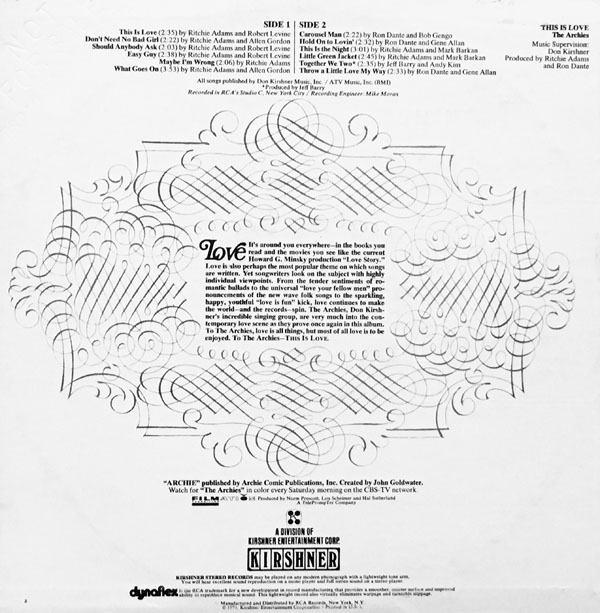
Mentioning Love Story’s producer certainly betrays the mandatory “marketing speak.” This is no passing reference, but more likely a clue to a mutual promotion deal for the album and film. Even though Love Story premiered two months before This is Love’s release, it was surely still in theaters when The Archies album debuted. Plus, one of its songs, “Together We Two,” had already been released as a single in 1970 (with “Everything’s Alright” from The Archies’ third album, the Jingle Jangle, which we covered here.
Lead singer (and multi-talented performer/producer) Ron Dante’s vocal on “This is Love” features the one and only time he performed spoken lines directly to the listener. This was a convention of late fifties/early sixties pop that had become a bit of a sigh-inducer by 1971, but not to those who assumed an intended target for the song—and especially not for the cross promotion, because of the words he says:
“Honey, I finally know what love is. This is our love story. Believe in it, and it will last forever.”
See what they did there? As my father used to say, “If it had teeth it would bite you, son.”
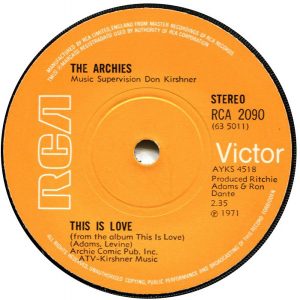 When you get beyond the gardenias, contracts and other machinations, there is still a lot to like about this album. True, the salad days of The Archies were behind them. The shelf life of such a thing is limited, but the group really didn’t even exist and yet their work was substantial and impactful.
When you get beyond the gardenias, contracts and other machinations, there is still a lot to like about this album. True, the salad days of The Archies were behind them. The shelf life of such a thing is limited, but the group really didn’t even exist and yet their work was substantial and impactful.
Perhaps the impending finality enabled the creative team to take a few risks on this disc. It’s the first album to use brass, on “What Goes On?” a tune with the tropical beat adopted with some other stylistic changes on the previous Sunshine album (see this Spin), which was also slightly more “mature” than the first two LP’s. The Archies were not The Beatles or even The Monkees, who grew and changed markedly over their history as groups, but there were noticeable alterations.
Ron Dante has a bigger creative role on This is Love than in the past, as the co-producer with Archie songwriter Ritchie Adams. The sole exception is the aforementioned “Together We Two,” written and produced by the “Sugar, Sugar” and “Jingle Jangle” team of Andy Kim and Jeff Barry, and produced by Barry. It offers a duet between Dante and studio singer Donna Marie.
This is Love is not just a romance album, it’s still peppy bubblegum with hook-laden ditties like “Little Green Jacket” and “Carousel Man.” Usually overlooked because it came so late in the first phased The Archies’ recording career, it deserves more than a passing glance.
“This is Love”
Enjoy Ron Dante’s Tiger Beat-worthy words of romance as well as mighty catchy arrangement.
‘
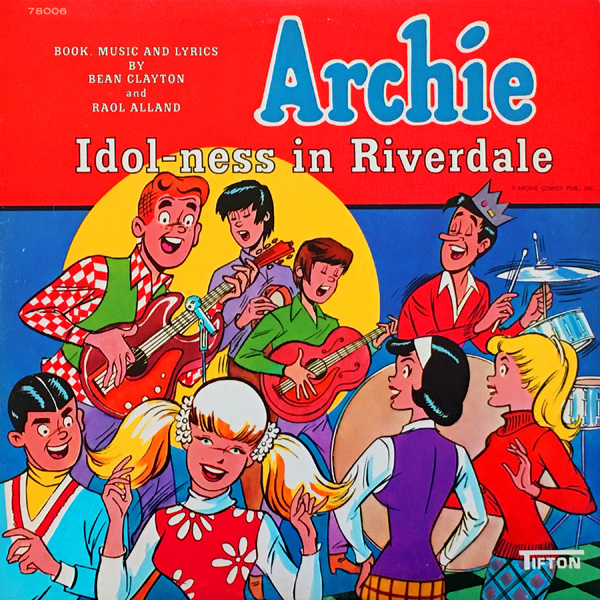
ARCHIE: Idol-Ness in Riverdale
Tifton Records (Peter Pan) #78006 (12” 33 1/3 RPM / Mono)
Released in 1966. Executive Producer: Martin Kasen. Book, Music and Lyrics: Bean Clayton, Raol Alland. Running Time: 49 minutes.
Historically, Idol-Ness in Riverdale is of note because it is the first time anyone dramatized and musicalized the Archie characters specifically for records and for pop music Archie was adapted for radio and live-action television comedy several times, but the Filmation series was two years away.Songs: “Gargoyles,” “What Do You Do?” “How,” “Friday Afternoon,” “Rehearsal Song,” “Anticipation,” “Rainbow in My Tears” by Bean Clayton, Raol Alland.
This album even predates The Archies, which were an adjunct to the 1968 animated series and Don Kirshner records. On this record, the band is called The Wonders. Reggie plays guitar, Jughead on drums, but Archie plays tambourine. Betty, Veronica and Big Ethel (who has a more substantial role here as a cohort with B & V than in most Archie comic book stories) are fans of a Beatles-like mop-top group called The Gargoyles. The plot involves a concert in which The Gargoyles can’t show and The Wonders take their place in disguise.
Peppering the proceedings are pleasant little children’s pop tunes. Tifton was one of Peter Pan’s record companies, so the same uncredited singers and musicians sound as if they performed the roles and sang the songs. Some sound like musicians called upon to be actors and vice-versa. They do the best they can but for some reason Jughead is made to sound more like Big Moose. One wonders whether this musical was written to also be done by schools and community groups, as is the case with many musicals on children’s records.
Tifton also released two albums of superhero musical records, Children’s Treasury of Batman Musical Stories and Children’s Treasury of Superman Stories. There are no narrative elements on those albums, just songs, but the style and performance are very similar, just as they are on other Peter Pan Records of the mid-sixties.
It’s very easy to chuckle along with the less-then-on-target character voices or pick on the humble production values of this album. These can be excused for any number of obvious reasons, starting with time and budget. However, what is lacking is any character detail beyond the name, rank and serial number. The dialogue seems less inspired by an ongoing readership of the Archie series than on a short stack of comic books rather. Archie comics are not Proust or Chekov, but there are signature character quirks and plots that are missing from the record.
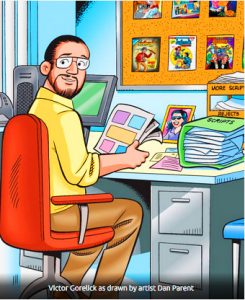 Which leads me to a tribute to a major name in “intellectual property” who we lost recently. His name is Victor Gorelick, editor of Archie Comics for well over 50 years.
Which leads me to a tribute to a major name in “intellectual property” who we lost recently. His name is Victor Gorelick, editor of Archie Comics for well over 50 years.
He had a file in his head of thousands upon thousands of Archie stories, jokes and gags in his head. He knew what had been done—and that was almost everything. His skill was recognizing how Archie’s best writers could—and still do—consistently turn 75 years of basic premises on their ears to be fresh again, That was the trick with the Archie series because since 1941-42 (depending on the historical source), there were basic plots, just as there are for westerns, science fiction and fantasy stories.
It’s impossible to so with algorithms, excel files and the latest programs. It’s even less possible—and much more precarious—with only cursory familiarity. Eventually all of those drop their façade because they can’t work with genuine intuitive creativity. This was vital to the core Archie universe, the basic storyline that has endured beyond the brand offshoots (except the pop band, which made entertainment history in 1969).
Just like Marvel and DC, Archie enjoyed limited dalliances in various “universes” for decades, following trends like The Man From U.N.C.L.E., superheroes, vampires, princess movies, futuristic satire, and so on. The recent Riverdale and Sabrina TV teen series are nothing new, they’re just higher profile (and even they are offshoots of successful trend setters like Dawson’s Creek and Buffy, the Vampire Slayer).
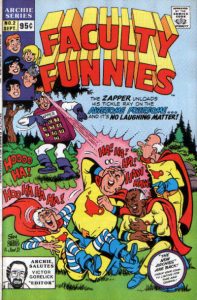 The core classic Archie situation comedy format still dominates the comic digests and recent classic-inspired series. Keeping the core going and maintaining the massive catalog was something that came from the human experience of someone like Victor Gorelick. (In his last role as Vice-President, doubtless his influence was instrumental in perpetuating this strength within the franchise.)
The core classic Archie situation comedy format still dominates the comic digests and recent classic-inspired series. Keeping the core going and maintaining the massive catalog was something that came from the human experience of someone like Victor Gorelick. (In his last role as Vice-President, doubtless his influence was instrumental in perpetuating this strength within the franchise.)
The challenge of writing for Archie was coming up with something that had not been done before. Victor knew the ideas that would work and was very encouraging. It was always a delight to speak with him because of his knowledge, enthusiasm and guidance.
Betty and Veronica are the most delightful characters to write as they are so clearly defined and offer so much wit and contrast. A specific dilemma is key with Archie-focused stories rather than his genial, everyman personality. The best Jughead stories are the more intricate ones where he plays mind games with Reggie and the underutilized Trula Twist. Helping Reggie make a fool of himself is fun and quite satisfying.
The Archie canon is the longest-running sitcom in entertainment history. While Victor Gorelik will not receive the hearts and flowers of a Stan Lee, he kept the characters and stories as consistent as possible. Archie and his friends had to change with the time yet remain the same. A superheroic achievement to be sure. I’m still reading, looking back on what he brought to the comics world, and looking forward to how it is carried on.
Archie Comics has a lovely tribute to Victor here at their site.
“Idol-Ness in Riverdale”
One can sometimes understand why reverb is used for music as it tended to “open up” the sound, but it tended to be overused on the fifties and sixties records. This album uses an inordinate and inexplicable amount of echo to the dialogue no matter where the characters are supposed to be. Maybe it’s intended to create a theatrical effect.



 GREG EHRBAR is a freelance writer/producer for television, advertising, books, theme parks and stage. Greg has worked on content for such studios as Disney, Warner and Universal, with some of Hollywood’s biggest stars. His numerous books include Mouse Tracks: The Story of Walt Disney Records (with Tim Hollis). Visit
GREG EHRBAR is a freelance writer/producer for television, advertising, books, theme parks and stage. Greg has worked on content for such studios as Disney, Warner and Universal, with some of Hollywood’s biggest stars. His numerous books include Mouse Tracks: The Story of Walt Disney Records (with Tim Hollis). Visit 





















































Now there’s a record I never thought I’d hear again! The Superman album was my first girlfriend’s favourite record when she was a little girl. She played it for me once, and I’m afraid I teased her pretty hard about it. But then she had the nerve to make fun of my Jungle Book album, which was going way too far. I guess I should have known it wasn’t going to work out in the long run.
Wonders vs. Gargoyles: The 1994 Tom Hanks film “That Thing You Do” tells the story of a fictional band called the Wonders, and their one hit song (with the same title as the movie) in the summer of 1964. The band was originally “The One-ders”, but disc jockeys kept calling them the “O’Needers”. An underrated film: the best thing about it is, even though the songs in it are all originals, they perfectly capture the pop music style of the mid-’60s. The Gargoyles, on the other hand, were a minor English punk rock band of the eighties.
I love the glockenspiel obbligato in “This Is Love”. At least they kept it within tasteful bounds, unlike Lancelot Link’s Evolution Revolution, which really went overboard with the tubular bells.
I LOVE the movie “That Thing You Do!” We love dining at Watson’s in Orange. It was filmed inside. The square was also used because it looks retro. But then a lot of Southern California still has remained remnants of the mid- and early-century look (like the super sixties Hanna-Barbera building).
Why do the characters on the ARCHIE: Idol-Ness in Riverdale cover all look like they’re in shock? I think the eyes needed to be corrected!
When I was a kid, I used to take a pencil eraser and erase the pupils, then draw them in where I wanted. Of course, I would never do this with a vintage collectible or personal property. But it was great fun with advertisements and celebrity photos because you can make the eyes go all over the place. We didn’t have your fancy-schmancy video games so we made do with a trusty Ticonderoga Number Two!
BTW, I think the art was done by George Peed, but I did not list it since he almost always signed his work and this does not seem as finished. It’s a bit below par. However it does have some of the telltale signs of how he redesigned characters in his own style.
Maybe someone else finished a quick sketch and Peed, seeing the finished art, was so stunned, made the eyeballs reflect his reaction. I have never seen such art style in any actual Archie comic book.
I’m impressed that you discovered the Pep Comics reference to the “This is Love” album, as the album is so obscurely shown on the bottom. But that is definitely the same album.
I know this is supposed to be about the audio, but I can’t help but observe the brilliant composition of the comic book cover. The letters at the top are in red bordered with white, matching some of the colors below. The flesh tones of the characters above with all of them dressed for the beach keep a uniform color balance on the top so as not to upstage the two scenes below. The positions of the characters surrounding “Pep” form a framework for the title word. The background of the title is the same as the background of the soda shop where Betty and Veronica are sitting, while the background of the record store features a marvelous rainbow/psychedelic effect which had become the norm by the mid-70’s. The shopkeeper has sideburns, a mustache, and a haircut that was very much in style at the time, plus his yellow tie matches with the cloud behind him and the poster below him, as well as the seat backs in the drugstore. Everybody else is wearing red and/or white. Jughead and Veronica are both upright with a straight up and down angle, and both dressed in red. Archie is leaning over the counter and his pose is the same angle as the soda in the poster above Betty’s head. The shopkeeper and Betty balance each other out, each in the same respective position relative to the main action, with Betty’s blonde hair echoing the shopkeeper’s yellow tie. Betty and Veronica are both dressed in red with some white–Veronica’s belt and Betty’s button, and Archie is wearing red pants and a white T-shirt. Of course, Archie is supposed to be the main focus, and his white T-shirt stands out because of the contrast with all of the color around him, so the eye is drawn immediately to Archie near the center of the cover. Often comic book covers are a “rush job” but n this case the artist took some time to develop the composition, not only of the various characters and elements but in terms of colors as well.
That’s a very cogent analysis. I have no background in graphic design, so your clear explanation of the use of colour, line and symmetry in the composition of the page is very instructive. From a staging standpoint, I would add that both Veronica and Archie are posed in an attitude of relaxed self-assurance — legs crossed casually, one hand on a hip — BUT they are looking in opposite directions. It shows their confidence that the birthday surprise will go over well, but as for their specific expectations they literally “don’t see eye to eye”. Makes you want to buy the issue and see what happens!